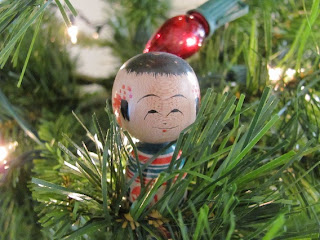For those who don't know, the Japanese people on the whole love American-style Christmas. That is, the lights, the decorations, and even Santa Claus. While the connection with Christianity seems to be vaguely understood in Japan, as we'll see below kokeshi makers are catering to the love of Christmas with some really creative designs. We have acquired a small collection of these kokeshis, and each Christmas Naoko pulls them out along with other Christmas decorations (see photos below). Meanwhile, in the spirit of kokeshi connoisseurship I bought a fake Christmas tree this year and covered it with small-sized traditional kokeshis. Many makers produce tiny kokeshis and put strings on them for use as cell-phone straps, and they happen to make perfect ornaments especially since their colors tend to be similar to Christmas colors. I found that smaller kokeshis can be secured to the tree using the fake tree's wire branches, so why not? Overall, I think we've started an innovative new kokeshi tradition.
 |
| Our kokeshi-themed Christmas tree. |
 |
| A small Sakunami kokeshi 作並系 by Mr. Hiraga Teruyuki 平賀輝幸さん. You can see that I wrapped the branch around the kokeshi to keep it in place. |
 |
| Another small Sakunami kokeshi by Mr. Hiraga. We received this and the one above at a recent Tokyo Kokeshi Tomo no Kai 東京こけし友の会 meeting. |
 |
| A nice Yamagata kokeshi 山形系 by Mr. Kobayashi Kiyoshi 小林清さん. |
 |
| A very unique Naruko kokeshi 鳴子系 by Mr. Izu Toru 伊豆徹さん. |
 |
| A small Zao kokeshi 蔵王系 by Mr. Mito Hiroshi 水戸寛さん. |
 |
| A mini Tsugaru kokeshi 津軽系 by Mr. Abo Kanemitsu 阿保金光さん. |
During a recent adventure to Sakunami Onsen 作並温泉 in the mountains near Sendai City we spent some time with traditional kokeshi craftsman Mr. Hiraga Teruyuki. I'll discuss that kokeshi adventure in an upcoming blog, but I did need to mention his Christmas kokeshis here. Naoko was completely taken with them, and they really are wonderful little handicrafts. I would guess that if they were brought to the US or Europe they would be extremely popular. Mr. Hiraga has four types that he creates for Christmas: Angels, Santa kokeshis, kokeshi Santas, and snowmen. He didn't have any snowmen when we were visiting, but we did get examples of the other kinds. These kokeshis definitely blur the line between traditional and modern kokeshis, though I would put them in the traditional camp 1) because they were made by a traditional kokeshi craftsman, and 2) because the faces are basically those of traditional kokeshis. In case you're wondering, Mr. Hiraga sells these little masterpieces for 1,000 yen a piece -- a bargain.
 |
| Mr. Hiraga's angel kokeshis. |
 |
| A Hiraga Christmas kokeshi. |
 |
| Two more Hiraga Christmas kokeshis. |
Another branch of Christmas kokeshis is Santas, and I'm always struck by the cleverness of these Japanese designers who are dealing with such a non-Japanese tradition. From what I can tell modern kokeshi makers were the first to make them, but traditional kokeshi makers are also creating these fun little holiday figures that even the most anti-Christmas scrooge could appreciate.

































